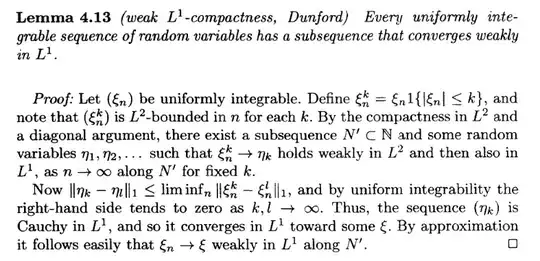I have been looking at this proof in Kallenberg's "Foundations of Modern Probability":
I can see that the Banach-Alaoglu theorem is being implicitly referenced, and I believe I understand the proof up to the last line:
By approximation it follows easily that $\xi_n \to \xi$ weakly in $L^1$ along $N'$.
My attempt to complete this last part of the proof goes like this:
Fix $\epsilon>0$. Since $\eta_k\to\xi$ in $L^1$, for sufficiently large $k$ we have $E|\eta_k-\xi|<\epsilon$. Also, by the uniform integrability of $\xi_n$, for sufficiently large $k$ we have $\sup_n E|\xi_n - \xi_n^k|<\epsilon$. So, choose a $k$ such that both these inequalities hold. Then, for this choice of $k$, since $\xi_n^k \to \eta_k$ in $L^1$ as $n\to\infty$ along $N'$, there is an $M$ such that $E|\xi_n^k-\eta_k|<\epsilon$ for $n \geq M$ in $N'$. Putting this together, we obtain $$E|\xi_n-\xi| \leq E|\xi_n-\xi_n^k| + E|\xi_n^k-\eta_k| + E|\eta_k-\xi| \leq 3\epsilon$$ for $n \geq M$ in $N'$. Since $\epsilon$ was arbitrary, this shows that $\xi_n\to \xi$ in $L^1$ along $N'$.
However, something seems to be wrong, since this proves too much. We should only be able to show weak convergence in $L^1$. Where is the mistake?
